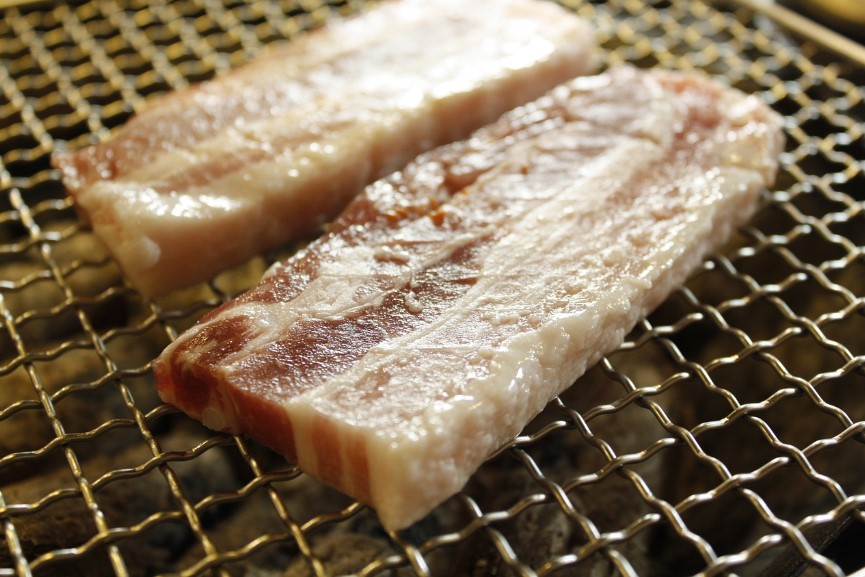Korean BBQ (Gogi-gui) is one of the most exciting and delicious parts of Korean cuisine, offering a social, interactive dining experience that’s both fun and flavorful. With a grill set right at the table, diners cook their own meat—whether it’s beef, pork, or chicken—accompanied by a variety of side dishes and sauces. Here’s what makes Korean BBQ so special:

1. Galbi (갈비) – Marinated Beef Short Ribs
One of the most famous cuts served at Korean BBQ is galbi, or marinated beef short ribs. These ribs are marinated in a sweet and savory sauce made from soy sauce, garlic, sugar, sesame oil, and pear juice, which tenderizes the meat and infuses it with rich flavors. Once grilled, the ribs are incredibly juicy, with a caramelized glaze on the outside. Galbi is typically wrapped in lettuce or perilla leaves with a bit of ssamjang (a savory dipping sauce) and garlic, creating the perfect bite.
2. Samgyeopsal (삼겹살) – Grilled Pork Belly
A staple at Korean BBQ, samgyeopsal is thick slices of pork belly, grilled without any marination. The meat is crispy on the outside and tender on the inside. It’s often eaten with dipping sauces like sesame oil with salt and pepper or wrapped in leafy greens with kimchi, garlic, and gochujang (Korean chili paste). The simplicity of samgyeopsal allows the natural flavors of the pork to shine, while the variety of banchan (side dishes) adds complexity to each bite.
3. Banchan (반찬) – Side Dishes
A key element of any Korean BBQ meal is the array of banchan (small side dishes) that accompany the meat. These can include kimchi, pickled vegetables, soy-marinated potatoes, steamed eggs, and more. Banchan not only adds flavor variety but also helps balance the richness of the grilled meat. The constant replenishing of banchan ensures that the meal stays dynamic, with new flavors complementing each bite of BBQ.
4. Ssam (쌈) – Lettuce Wraps
A highlight of Korean BBQ is the practice of making ssam—delicious wraps made by placing a piece of grilled meat in a fresh lettuce or perilla leaf, then adding rice, garlic, ssamjang, and pickled radishes. The crispness of the greens contrasts with the rich, smoky meat, creating a perfect balance of flavors and textures. Ssam is a refreshing way to enjoy BBQ while keeping the meal light and flavorful.
5. Gochujang and Ssamjang – The Essential Sauces
Korean BBQ wouldn’t be complete without its essential sauces: gochujang and ssamjang. Gochujang is a spicy, slightly sweet fermented chili paste that adds heat and depth to every bite. Ssamjang is a thicker, savory paste made from doenjang (fermented soybean paste), gochujang, garlic, and sesame oil, offering a rich, umami flavor. These sauces are typically used as condiments to enhance the grilled meats and wraps.
The Social Aspect of Korean BBQ
One of the best things about Korean BBQ is the interactive, communal nature of the meal. It’s not just about eating—it’s about cooking together, sharing food, and creating a memorable experience. The act of grilling your own meat at the table, choosing from a wide variety of side dishes, and assembling ssam wraps makes it a fun and engaging dining experience. It’s common for friends and family to gather around the grill, making Korean BBQ a perfect choice for group dining.
Pairing Korean BBQ with Drinks
Korean BBQ is often enjoyed with soju (a Korean distilled spirit) or makgeolli (a traditional rice wine). Soju’s clean, slightly sweet taste complements the rich flavors of grilled meat, while makgeolli, with its creamy and tangy notes, pairs well with the BBQ’s smoky and savory elements. Sharing drinks while cooking and eating adds another layer of enjoyment to the meal.
Conclusion
Korean BBQ is more than just a meal—it’s a shared experience that brings people together over delicious, sizzling cuts of meat, fresh vegetables, and a variety of flavorful sides. Whether you’re indulging in marinated galbi, enjoying the simplicity of samgyeopsal, or building the perfect ssam wrap, Korean BBQ is an unforgettable way to experience Korea’s rich culinary traditions. The social aspect, combined with the wide range of flavors and textures, makes it one of the most beloved and iconic parts of Korean cuisine.
